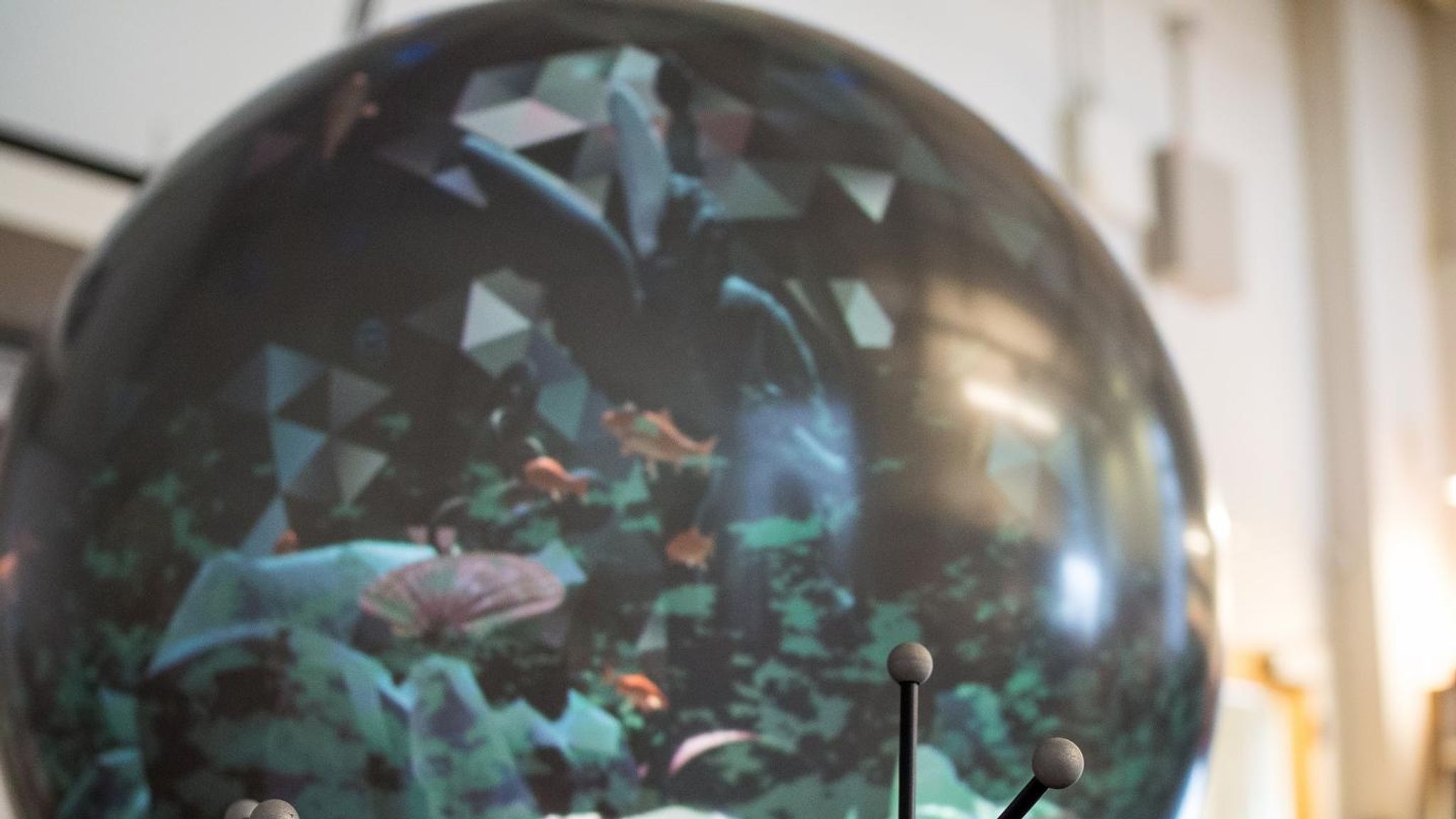
This article will help you understand the sources of real-time distortion in spherical displays, solutions to address it, and techniques for optimizing content.
1. What is a Spherical Display?
A spherical display is a 360° fully immersive display sphere composed of multiple curved LED modules, supporting high brightness and high refresh rates for dynamic content playback.
A spherical display is a three-dimensional display device, typically presented as a complete spherical structure, used to showcase immersive images, panoramic videos, and more. This type of display is constructed by piecing together multiple screens or a single large screen, enabling a 360° viewing experience.
Applications
It is widely used in virtual reality, immersive exhibitions, museums, advertising, entertainment, and more.
Commercial Displays: Luxury brand pop-up stores (e.g., Louis Vuitton’s Tokyo spherical window display, increasing interaction conversion rates by 40%)
Science Education: Planetarium dynamic star map projections (e.g., Beijing Planetarium’s 8K spherical display system)
Cultural Tourism and Entertainment: Theme park panoramic spherical theaters (e.g., Disney’s Guardians of the Galaxy spherical theater)
Differences Between Spherical LED Displays and Traditional Displays
Traditional displays (such as flat LED, LCD, and projection screens) present two-dimensional images, allowing viewers to watch from a fixed angle. In contrast, spherical displays provide an all-around, multi-angle visual experience.
Display Effects: Spherical displays can showcase more immersive content, enhancing the audience’s sense of space, especially in large-scale events like concerts or sports games.
Design Complexity: Traditional displays typically require simpler technology, while spherical LED displays must account for curved surfaces, viewing angle differences, and content adaptation.
2. Sources and Causes of Real-Time Distortion
2.1 Definition of Distortion
When content is played on a spherical display, images or videos may become distorted on the curved screen, leading to visual inaccuracies. Particularly during real-time playback, content may not fully match the spherical surface, resulting in noticeable visual errors.
2.2 Factors Contributing to Real-Time Distortion
Geometric Deformation: The curved surface of a sphere LED display causes content to stretch or compress to fit the screen’s geometry. Compared to flat displays, spherical screens require specific processing of images or videos to avoid distortion.
Viewing Angle Differences: Due to the immersive nature of spherical screens, the viewer’s perspective changes as they move. This variation can cause content to appear inconsistent from different angles, leading to distortion.
Resolution and Pixel Density: If the resolution is insufficient or the pixel density cannot cover the entire spherical display, details may appear blurry or distorted.
Content Mismatch: Not all content can seamlessly adapt to spherical screens. Ordinary flat videos or images, when projected onto a sphere LED screen, are prone to deformation, causing misalignment or distortion.
3. Solutions and Optimization Techniques for Real-Time Distortion
Software Techniques: Surface Mapping and Distortion Correction
Spherical Mapping: A technique that uses mathematical algorithms to map images or videos from a flat plane to a spherical surface. This method effectively prevents stretching or compression, reducing distortion.
Real-Time Correction Algorithms: During playback, real-time distortion correction algorithms dynamically adjust the shape of images or videos to fit the geometric structure of the spherical display. For example, inverse transformation techniques can repair image or video distortion.
Perspective Correction: Adjusts the perspective of images or videos to ensure they appear natural and distortion-free from all angles, especially at the edges of the spherical display.
Hardware Techniques: High-Resolution Displays and Precise Control
High-Resolution Displays: Increasing the resolution of spherical displays ensures higher-quality image output. High-definition displays reduce distortion and blur caused by insufficient pixel density.
Specialized Display Panels: Using curved display panels or dedicated spherical display units tailored to the characteristics of spherical displays minimizes distortion and provides more natural playback.
Hybrid Techniques: Content Optimization and Preprocessing
Content Adjustment: During the content creation phase, videos or images should be designed and produced with the spherical display’s characteristics in mind. This may include distortion, angle adjustments, and more to prevent distortion on the spherical screen.
Content Segmentation and Stitching: Large-scale content can be divided into segments suitable for spherical displays and precisely stitched to ensure seamless transitions and reduce distortion.
4. Handling Content for LED Sphere Displays
Designing and Adjusting Content for LED Sphere Displays
3D Modeling and Virtual Reality Content: Spherical displays are ideal for showcasing 3D models and virtual reality content. Designers must ensure balanced presentation on the spherical screen and use modeling software to preview effects, avoiding distortion.
Panoramic Videos and Surrounding Audio Effects: During production, adjust video perspectives and resolutions to fit the curved surface of spherical displays. Panoramic videos leverage the advantages of spherical screens to deliver immersive experiences.
Color and Lighting Adjustments: The curved surface of a sphere LED display may affect brightness uniformity. Therefore, adjust brightness, contrast, and colors to prevent distortion or uneven display in certain areas.
Dynamic Correction and Adaptation Techniques
Real-Time Image Correction: During playback, real-time correction techniques can automatically adapt to viewer perspective changes, ensuring optimal display effects. Precise sensors and control systems enable real-time adjustments to the displayed image.
5. Future Trends
Innovations in Sphere LED Display Technology
As technology advances, spherical displays will see breakthroughs in resolution, color, and lighting adaptation. For example, higher-resolution display technologies and smarter correction algorithms will significantly improve display quality and reduce distortion.
Application Prospects
Spherical displays will be widely used in virtual reality, immersive experiences, advertising, and museum exhibitions. With continuous advancements in content creation and display technology, future displays will offer smoother, distortion-free visual experiences, further enhancing user immersion.
Integration with AI and Big Data
With the development of AI and big data, content management and real-time adjustments for spherical LED displays will become more intelligent. AI can analyze viewer behavior and preferences to automatically adjust content, optimizing the user experience.
6. Conclusion
By effectively utilizing software and hardware technologies and considering the unique characteristics of spherical displays during content creation, we can significantly reduce real-time distortion. As technology continues to evolve, spherical displays will find broader applications, delivering increasingly perfect immersive experiences. If you have further questions, feel free to leave a comment for RTLED.
Post time: Mar-04-2025




